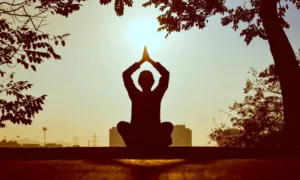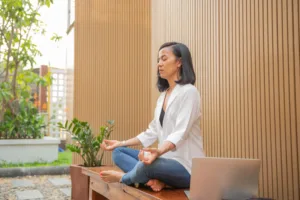What is Mindfulness? The Fascinating Art of Being Present
Mindfulness has gained significant popularity in recent years. It has become a buzzword in health and wellness circles, as well as in corporate settings. But, what is mindfulness exactly? What is the meaning of mindfulness? Let’s take a closer look!
What is Mindfulness? Mindfulness Definition
Mindfulness is all about focusing your awareness of the present moment, non-judgmentally, it is a mental state defined by an open-minded state of being aware of the current moment. It involves paying attention to your thoughts, feelings, and physical senses in a way that is free from distractions and judgment. This means that you observe your experiences without getting caught up in them or trying to change them.
One of the reasons mindfulness has become so popular is that it is an easy and accessible practice that can be done anywhere, at any time. You don’t need any special equipment or training to practice mindfulness. You only need the willingness to be present and observant of your experiences.
As you practice mindfulness, you may find that your mind wanders or that you get caught up in thoughts or emotions. This is completely normal. It is not about eliminating thoughts or emotions. What is mindfulness in simple terms is observing your thoughts without getting caught up in them.
Mindfulness vs. Meditation
The practice of mindfulness has its origins in Buddhist meditation, but it has been adapted globally in modern times.
Mindfulness teaches us to accept and pay attention to our thoughts, feelings, and what is happening around us. By practicing mindfulness, we make better choices in responding calmly or empathetically when we are faced with such challenges. With prolonged practices of mindfulness, you can be more patient and find a sense of compassion for yourself, as well as teach your mind to be still.

Meditation is slightly different from mindfulness. Meditation is a tool and a practice to train yourself and your mind in building awareness and creating a healthy sense of perspective.
It requires you to focus intentionally with an array of different forms and techniques, depending on what your intent is. By meditating, you alter a state of consciousness that connects you to your deeper sense of inner self.
Benefits of Mindfulness
There are many benefits of mindfulness, both for your mental and physical health. Studies have shown that mindfulness can help reduce stress, anxiety, and depression, as well as improve cognitive and immune system functions. It has also been shown to improve relationships and increase feelings of well-being and happiness.
Another great benefit of mindfulness is that it can help with boosting your memory. In a 2018 study, participants either undertook four weeks of mindfulness training or took a creative writing course. The tests showed that those who had been training in practicing mindfulness showed more remarkable proactive interference decreases. The proactive interference is your older memories interrupting your ability to create or access new memories. Thus, mindfulness shows significant improvements in the participant’s short-term memories.
Research has also indicated that mindfulness can also help to relieve the symptoms of many different health conditions, such as fibromyalgia, psoriasis, and type 2 diabetes.
With regular practice, you may find that mindfulness becomes a natural part of your daily life and you may find yourself more present and alert in your interactions with others. In addition to being more aware of your own thoughts and feelings, and being able to manage stress and anxiety.
Mindfulness is a powerful tool for improving your mental and physical health, and for developing a greater sense of well-being and happiness in your life. With frequent practice, mindfulness can lead you to a richer and more generous experience of life.
How do I practice mindfulness?
We believe that mindfulness is a skill that anyone can learn, no matter how new you may be to the practice. Here are some simple ways that you can practice mindfulness:
1. Take a moment to breathe before you start your day (you’ll be amazed at how much this helps!).
2. Try to take some time out of the day by going for a walk. This will give you time to unwind, clear your head, and keep both your mind and body fit.
3. Slow down and pay attention to things around you. Take the time to experience the environment with your senses – sight, smell, taste, sound, and touch. For example by listening to your favorite song, and hearing how the instruments are being played, or the singer’s tone of voice.
4. Find some kind of joy in your everyday life and live in the moment. Even if it wasn’t a good day, always try to find some good things about it, and remember tomorrow is always a new day.
6. Treat yourself as you would treat a good friend, and respect yourself for who you are and what you are not. Everyone is different and we aren’t made to be perfect.
If you are looking for more structured mindfulness exercises, you could try:
1. Body Scan Meditation: Lie on your back with your legs extended and arms at your sides with your palms facing up. Focusing slowly the attention on each part of your body, in order from head to toe, or toe to head. Be aware of any feelings, emotions, or thoughts that you may encounter with each part of your body.
2. Sitting Meditation: Find somewhere where you can sit comfortably, with your back straight, feet flat on the floor, and hands in your lap. Focus on your breathing and be sure to breathe from your nose. If any thoughts or sensations interrupt you, note them without judgment or attachment, and focus back on your breathing
3. Walking Meditation: Find a good quiet place like a park or forest and begin to slowly walk around. Focus on your experiences while you are walking, being aware of how your body walks and how it keeps you upright and balanced. When you reach the end of the path, turn back and continue walking and maintaining this form of awareness. You can also engage your senses to smell, touch, hear and see nature around you.
Are you curious about how long you should practice mindfulness? It’s a common question, but the answer varies based on your individual preferences and circumstances. However, experts recommend practicing mindfulness for at least 10 to 20 minutes every day for maximum benefits. Don’t worry too much about the duration, though! Consistency and frequency in your practice are more crucial than the length of time you spend on it. Remember, mindfulness is a skill that needs to be honed over time to truly gather its rewards. So, keep practicing and enjoy the journey!
How do I become more mindful?

Whether you are new to mindfulness or meditation, or if you have been practicing for years, there are many resources available to help you deepen your practice and experience its benefits. One of the best ways to develop and deepen your mindfulness journey is through meditation. At Samavira our 6-week meditation trainings are designed to support you in creating your very own unique style of meditation that works for you, so why not give it a try and see for yourself what Samavira can do for you?
Enjoyed this article? Share it!
Keep reading!

5 Best Types of Music for Meditation
Meditation is a profound practice that connects the mind, body, and soul. While silence can be powerful, adding music to your meditation routine can elevate

How Meditation Can Enhance Emotional Connection in Relationships
In recent years, meditation has gained widespread attention for its profound impact on personal well-being. But did you know it can also play an important

Embracing Stillness: 4 Simple Meditation Techniques for Overcoming Cravings
Cravings can be relentless, whether you’re dealing with the urge to eat unhealthy foods, the pull of an addictive substance, or even the compulsion to

Sleep Better, Live Better: Meditation for Insomnia Relief
Insomnia affects millions of people worldwide, leading to various health issues such as fatigue, irritability, and a weakened immune system. One effective method to combat

Clarity Amidst Chaos: How to Use Meditation for Concentration and Focus
Let’s talk about why meditation for concentration and focus is important. Focus is a crucial aspect of daily life that allows individuals to concentrate their

Meditation for Emotional Resilience: A How-to Guide
Meditation is a powerful tool that can help build emotional resilience. In our daily lives, we encounter various stressors and challenges that can impact our

